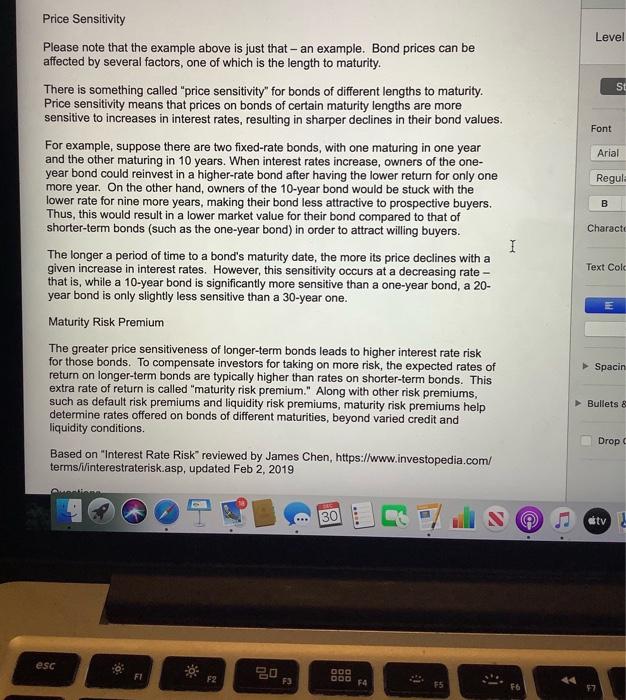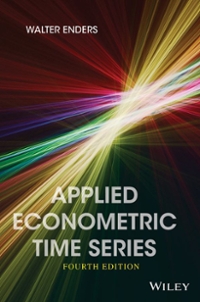Level St Font Arial Regul B Charact Price Sensitivity Please note that the example above is just that - an example. Bond prices can be affected by several factors, one of which is the length to maturity. There is something called "price sensitivity" for bonds of different lengths to maturity. Price sensitivity means that prices on bonds of certain maturity lengths are more sensitive to increases in interest rates, resulting in sharper declines in their bond values. For example, suppose there are two fixed-rate bonds, with one maturing in one year and the other maturing in 10 years. When interest rates increase, owners of the one- year bond could reinvest in a higher-rate bond after having the lower return for only one more year. On the other hand, owners of the 10-year bond would be stuck with the lower rate for nine more years, making their bond less attractive to prospective buyers. Thus, this would result in a lower market value for their bond compared to that of shorter-term bonds (such as the one-year bond) in order to attract willing buyers. The longer a period of time to a bond's maturity date, the more its price declines with a given increase in interest rates. However, this sensitivity occurs at a decreasing rate - that is, while a 10-year bond is significantly more sensitive than a one-year bond, a 20- year bond is only slightly less sensitive than a 30-year one. Maturity Risk Premium The greater price sensitiveness of longer-term bonds leads to higher interest rate risk for those bonds. To compensate investors for taking on more risk, the expected rates of return on longer-term bonds are typically higher than rates on shorter-term bonds. This extra rate of return is called "maturity risk premium." Along with other risk premiums, such as default risk premiums and liquidity risk premiums, maturity risk premiums help determine rates offered on bonds of different maturities, beyond varied credit and liquidity conditions. Based on "Interest Rate Risk reviewed by James Chen, https://www.investopedia.com/ terms/i/interestraterisk.asp, updated Feb 2, 2019 Text Cold Spacin Bullets & Drop 30 a etv esc 20 FI F2 000 DOO F3 4 F4 7 been chosen. 5. a. What happens to the opportunity cost of owning a bond when interest rates increase? if interest rates then increase the opportunity cost of owning that bond increases because the investor is losing out because newly issued bonds have a higher rate of interest. b. What happens to the opportunity cost of owning a bond when interest rates decrease? this will be reflected in the price of the bond on the bond market it will decrease.if a person purchases a bond with a certain interest rate and interest rates then decrease the opportunity cost of owning that bond decreases because newly issued bonds have a lower rate of interest. What is price sensitivity for bonds of different lengths to maturity? | What occurs to a bond's price based on its maturity date if interest rates increase? b. Does what occurs in #7a occur at a steady rate? What occurs to interest rate risk based on the greater price sensitiveness of longer-term bonds? b. Based on what occurs in #8a, how are investors compensated? I 6. 7. a. 8. a. b. 30 esc 8 FI 000 DOO FZ FA # Level St Font Arial Regul B Charact Price Sensitivity Please note that the example above is just that - an example. Bond prices can be affected by several factors, one of which is the length to maturity. There is something called "price sensitivity" for bonds of different lengths to maturity. Price sensitivity means that prices on bonds of certain maturity lengths are more sensitive to increases in interest rates, resulting in sharper declines in their bond values. For example, suppose there are two fixed-rate bonds, with one maturing in one year and the other maturing in 10 years. When interest rates increase, owners of the one- year bond could reinvest in a higher-rate bond after having the lower return for only one more year. On the other hand, owners of the 10-year bond would be stuck with the lower rate for nine more years, making their bond less attractive to prospective buyers. Thus, this would result in a lower market value for their bond compared to that of shorter-term bonds (such as the one-year bond) in order to attract willing buyers. The longer a period of time to a bond's maturity date, the more its price declines with a given increase in interest rates. However, this sensitivity occurs at a decreasing rate - that is, while a 10-year bond is significantly more sensitive than a one-year bond, a 20- year bond is only slightly less sensitive than a 30-year one. Maturity Risk Premium The greater price sensitiveness of longer-term bonds leads to higher interest rate risk for those bonds. To compensate investors for taking on more risk, the expected rates of return on longer-term bonds are typically higher than rates on shorter-term bonds. This extra rate of return is called "maturity risk premium." Along with other risk premiums, such as default risk premiums and liquidity risk premiums, maturity risk premiums help determine rates offered on bonds of different maturities, beyond varied credit and liquidity conditions. Based on "Interest Rate Risk reviewed by James Chen, https://www.investopedia.com/ terms/i/interestraterisk.asp, updated Feb 2, 2019 Text Cold Spacin Bullets & Drop 30 a etv esc 20 FI F2 000 DOO F3 4 F4 7 been chosen. 5. a. What happens to the opportunity cost of owning a bond when interest rates increase? if interest rates then increase the opportunity cost of owning that bond increases because the investor is losing out because newly issued bonds have a higher rate of interest. b. What happens to the opportunity cost of owning a bond when interest rates decrease? this will be reflected in the price of the bond on the bond market it will decrease.if a person purchases a bond with a certain interest rate and interest rates then decrease the opportunity cost of owning that bond decreases because newly issued bonds have a lower rate of interest. What is price sensitivity for bonds of different lengths to maturity? | What occurs to a bond's price based on its maturity date if interest rates increase? b. Does what occurs in #7a occur at a steady rate? What occurs to interest rate risk based on the greater price sensitiveness of longer-term bonds? b. Based on what occurs in #8a, how are investors compensated? I 6. 7. a. 8. a. b. 30 esc 8 FI 000 DOO FZ FA #








